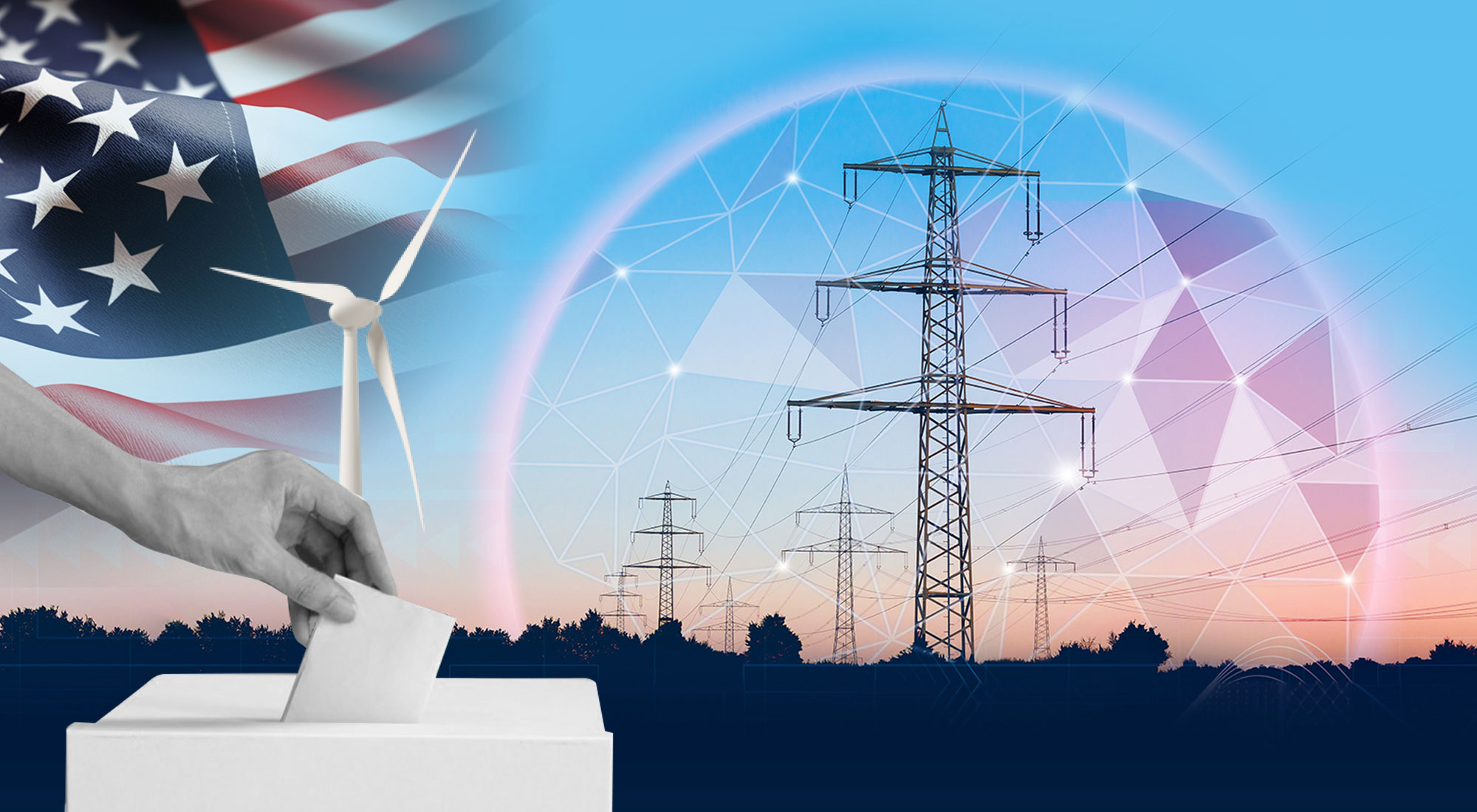In the run-up to the next U.S. presidential elections, energy security is becoming an increasingly important issue. Candidates’ suggested methods for improving energy security are being closely examined as they present their energy agendas. While some place greater emphasis on attaining energy independence, others give priority to more general goals related to energy security. This includes producing and distributing energy domestically, making sure the energy supply is diversified and sustainable, and combating climate change by reducing emissions. The 2024 elections are expected to set off a critical discussion on how to strike a balance between energy security and the threats posed by climate change. This is going to be a hot topic for the world community, which will be watching the decisions taken by the U.S. and its leadership in tackling the world’s energy problems very carefully.[1]
Clean energy advances are being highlighted in the 2018 U.S. presidential elections, as Kamala Harris and the Democrats stress their accomplishments in this field. Republicans, however, are critical of these developments, so Democrats must respond strategically. Democrats must effectively convey the advantages of renewable energy technology for the economy and national security if they hope to win in 2024. Brenda Shaffer, an energy security expert, observes that the absence of a cabinet member specifically tasked with overseeing foreign energy policies and the diminished focus on energy security in national plans are signs that the Biden administration has moved U.S. energy policy away from emphasizing energy security. While the elections do not directly deal with international energy policy, the results will have a big impact on America’s position on the subject, particularly because the Biden administration’s policies have allowed China to expand its influence in emerging nations.[2]
A possible change in leadership within the Democratic Party while upholding the basic ideas and policies of the Biden administration is represented by Kamala Harris’s campaign. Energy policy is a crucial area of attention for the presidential election campaign since it affects economic development, environmental sustainability, and national security. To expedite the shift to a clean energy economy, the Democratic Party intends to achieve net-zero greenhouse gas (GHG) emissions by 2050 and has large expenditures planned for renewable energy technologies.[3]
In comparison to Joe Biden, Harris has a more ambitious record and is well-known for her progressive views on energy-related problems. During her time as a senator and the 2020 Democratic presidential primary, she backed policies that outlawed the use of plastic straws, forbade hydraulic fracturing, and did away with the filibuster. As a founding co-sponsor of the Green New Deal, she backed programs that helped shape the Inflation Reduction Act into law. The Climate Equity Act of 2020, which covers how climate policies affect underprivileged areas, has Harris as a co-sponsor. She did clarify, though, that the ticket did not want to outlaw fracking—a contentious subject in key states like Pennsylvania and Ohio—during her vice-presidential campaign.[4]
Voters’ opinions on sustainable energy and associated topics are highlighted in a recent study conducted by Third Way’s Climate and Energy Program. Even though many Americans are more concerned about the economy than climate change, there is strong support for spending on renewable energy. The poll also reveals a lack of confidence between Trump and Biden over economic and energy-related issues, underscoring the necessity of strong messaging and a well-thought-out plan to sway public opinion and win over voters in the approaching elections.[5]
How Democratic presidential candidates propose to address climate change through energy policy
In the 2024 U.S. presidential elections, the Democratic contenders have put out several plans to combat climate change through energy-related initiatives. Among these strategies are:
Switch to Renewable Energy: A lot of Democratic contenders are in favor of a quick switch to renewable energy sources, such as wind and solar energy. They suggest large-scale expenditures on renewable energy infrastructure, tax breaks for the generation of renewable energy, and energy-efficiency-promoting regulations.[6]
Carbon Pricing: To place a price on carbon emissions and encourage reductions, several Democratic candidates are in favor of carbon pricing measures like carbon taxes or cap-and-trade programs. Some have voiced doubts over the ability of carbon pricing to quickly reduce emissions. Most Democratic contenders are in favor of reaching the Paris Agreement’s target of having net-zero GHG emissions by 2050. To accomplish this, they suggest several initiatives, such as boosting renewable energy, improving energy efficiency, and lowering emissions from industry and transportation.[7]
Energy Efficiency: When it comes to cutting emissions and advancing sustainable energy systems, Democratic candidates stress the significance of energy efficiency. They suggest laws to increase industrial, transportation, and building energy efficiency.[8]
Clean Energy Workforce: A few Democratic contenders suggest funding job development and training programs to create a workforce with a clean energy background. This would make it easier to guarantee that the shift to a low-carbon economy is just and advantageous to all communities.[9]
International Collaboration: To combat climate change, Democratic contenders stress the importance of international collaboration. They suggest collaborating with other nations to create and carry out international climate policies and aiding poor nations’ attempts to mitigate the effects of climate change and adapt to them.[10]
Infrastructure and Transit: Democratic contenders suggest funding the installation of environmentally friendly infrastructure, such as public transit and charging facilities for electric vehicles (EVs). Additionally, they are in favor of laws that encourage the use of electric cars and other low-emission modes of transportation.[11]
Phaseout of Fossil Fuels: A few Democratic contenders suggest eliminating fossil fuels in the ensuing decades, especially coal and oil. They contend that doing so is essential to achieving net-zero emissions and addressing the negative effects that fossil fuel extraction and combustion have on human health and the environment.[12]
Reforestation and regenerative agriculture: These are two examples of sustainable agricultural and forestry methods that some Democratic candidates have proposed enacting legislation to support to store carbon dioxide and lower emission.[13]
Climate Justice and Equity: Democratic presidential contenders in 2024 emphasize equitable mitigation of climate change, with a particular emphasis on the most disadvantaged populations. Their energy policies prioritize carbon pricing, investing in renewable energy sources like solar and wind, and fostering international collaboration through global climate rules and aid for underdeveloped countries.[14]
Essential Elements of Kamala Harris’s Energy Strategy
The energy strategy of Kamala Harris is distinguished by her steadfast dedication to halting climate change and establishing a clean energy economy. Her strategy combines investments with a community emphasis, aggressive legislative objectives, and a strong opposition to fossil fuels.
Investing in Climate Action in Communities
A key component of Vice President Harris’s energy plan includes financing for community-based climate initiatives. Her newly announced US$20 billion investment plan would help regional efforts to improve energy efficiency and cut emissions by directing cash via community lenders and organizations. This strategy tackles climate change at the local level, boosts employment, expands economic prospects, and encourages environmentally friendly behavior in local communities. Harris wants to stimulate social and economic progress while providing measurable benefits by emphasizing local environmental care.[15]
Legislative Achievements
Vice President Harris has played a key role in moving important climate legislation forward throughout her administration. Notably, her office has been a major supporter of the Inflation Reduction Act, which seeks to reduce emissions by 40% below 2005 levels by 2030. This historic measure demonstrates her dedication to renewable energy sources.[16] Harris’s commitment to environmental preservation is further evidenced by her aggressive pursuit of large oil firms for environmental infractions during her stint as California’s attorney general. Her aggressive approach to making polluters responsible for their actions demonstrates her larger dedication to legal and legislative initiatives that promote environmental stewardship and climate action.[17]
Public Reception and Political Implications
Many individuals firmly support Harris’s energy plans, particularly the younger generations who place a higher priority on environmental sustainability and climate action. Her dedication to renewable energy initiatives and strict liability for oil and gas firms is in line with the increasing need for preemptive climate action. Polls repeatedly demonstrate that her approach is more popular than that of her competitors, which increases her appeal to those who care about the environment.[18] Her strong opposition to fracking and fossil fuels, however, could draw criticism from local stakeholders and companies that depend on these energy sources for financial stability, which might lead to political difficulties in governments that produce fossil fuels.[19]
Kamala Harris’s Energy Transition Policy
Kamala Harris’s energy transition proposal, which emphasizes a significant move toward renewable energy and technological innovation, is a crucial part of her larger climate agenda. This change is essential for both domestic requirements and the continued competition in renewable energy technologies between China and the United States.
Objectives and Capital Outlays
As part of the Biden administration’s aggressive climate goals, Harris is in favor of a complete energy transition that drastically reduces GHG emissions. The administration wants to achieve net-zero emissions by 2050 and a 50% reduction in emissions by 2030. The Inflation Reduction Act’s almost US$369 billion in incentives is only one of the large expenditures that support this approach. These funds support the advancement of green technologies, the usage of EVs, and the development of alternative energy sources.[20] This plan aims to promote economic expansion and scientific advancement in the clean energy industry, in addition to quickening the transition to a sustainable energy future. Harris has underlined that although renewable energy investments combat climate change, they also promote economic growth and employment creation. Her government places a high priority on boosting renewable energy sources’ capacity, improving energy efficiency, and promoting the creation of clean energy supply chains on a national and worldwide scale.[21]
Equity and Justice in Energy Policy
Fairness and equity are highly valued in Harris’s energy transition strategy. She has proposed initiatives to support disadvantaged populations that are disproportionately affected by pollution and climate change. This entails making certain that low-income neighborhoods profit from the transition to a green economy and allocating funding for renewable energy projects in these regions.[22]
Biden vs. Harris: Divergent Approaches to Energy Policy
In contrast to her colleagues, Harris places greater emphasis on an aggressive and progressive energy plan that opposes fossil fuels and takes a comprehensive approach to climate solutions. As a senator, Harris condemned practices like offshore drilling and hydraulic fracturing, lambasted the oil and gas industry, and demanded more regulations pertaining to the extraction of fossil fuels.[23] With the goal of achieving net-zero emissions by 2050 and advancing renewable energy technologies, she co-sponsored the Green New Deal. To significantly cut GHG emissions, Harris suggested a “climate pollution fee” and backed legislation that would assess how policies would affect historically underprivileged areas’ environmental conditions.[24]
With a focus on cutting back on the use of fossil fuels and supporting robust climate legislation, Harris’s energy policy is more progressive than Biden’s. While Biden takes a more balanced approach, combining environmental preservation with economic growth, she pushes for stricter restrictions and a speedier shift to renewable energy.[25] Unlike Biden, who takes a more accommodating stance, Harris appears ready to go on the fossil fuel industry head-on, given her experience as a senator and attorney general. Therefore, although both politicians are committed to halting global warming and advancing renewable energy, Biden’s pragmatic approach is less radical and more aggressive than Harris’s ideas.[26]
U.S.-China Competition in Energy Transition Technology
The U.S. and China are fierce competitors in the clean energy sector as they vie for supremacy in renewable energy technologies. China has a large market share in the world, particularly in industries like solar energy, electric cars, and lithium-ion batteries because of its massive expenditures in supply chain development and manufacturing capacity.[27] On the other hand, to become less dependent on foreign technology, the U.S. is stepping up its efforts to improve domestic competitiveness through investments in clean energy innovation and infrastructure. The strategic significance of clean energy in promoting technical innovation, economic growth, and environmental sustainability—and so influencing future geopolitical and economic landscapes—is highlighted by this rising rivalry.[28]
Donald Trump’s Energy Policy
The projected energy strategy of Donald Trump for 2024 is like that of his previous administration in that it expresses skepticism about climate change and favors the growth of fossil fuels above renewable energy and climate action. Anticipations encompass elevated domestic energy output, diminished industry restrictions, potential reversals of initiatives such as the Clean Power Plan, and sustained backing for fossil fuel-derived infrastructure undertakings. According to The Washington Post, when Trump was the Republican nominee for president, he allegedly asked for US$1 billion at his Florida Mar-a-Lago club from executives in the oil business, pledging to reverse environmental rules put in place by the Biden administration if re-elected. The report was neither confirmed nor refuted by the Trump campaign. A spokesman for Trump denounced Biden’s environmental policy as radical, while Biden’s camp charged that Trump was siding with Big Oil over regular Americans. There are rumors that Trump promised to loosen drilling regulations in the Alaskan Arctic, expand oil leases in the Gulf of Mexico, and reverse the Biden administration’s ban on LNG export licenses.[29]
How Trump 2.0 could transform the Department of Energy
Should Trump win a second term, the Department of Energy (DOE) may undergo a dramatic reform that will prioritize increased activity related to oil and gas, aggressive deregulation, and a move away from renewable energy sources. The path of DOE is less certain because of its role in managing money for renewable energy from recent legislation, but changes at agencies like the Interior Department and the EPA are more apparent. Although Trump’s campaign did not provide a specific energy policy, it is anticipated that his government will prioritize domestic production of fossil fuels and scale back initiatives in the renewable energy space. The future of DOE programs, workforce levels, and the impact of business and legislative interests on Congress continue to be erratic elements influencing U.S. energy policy.[30]
The LNG pause
If Trump secures the presidency, the future of U.S. LNG shipments to Europe becomes uncertain, raising concerns about potential leverage over Europe. Speculation suggests Trump may impose a “U.S. security tariff” on LNG supplies to Europe, potentially leading to price inflation within the EU. Trump’s ambivalence toward Ukraine and affinity for Russian President Vladimir Putin suggest that geopolitics surrounding gas may gain prominence under his administration. Despite these concerns, Russian gas remains cheaper than U.S. LNG in the short term, as evidenced by record-breaking usage of Russian and Norwegian pipeline gas in Europe.
Alix Frangeul-Alves and Douglas Hengel anticipate that a second Trump administration would prioritize “energy dominance,” withdraw from the Paris Climate Agreement and promote energy exports, while a reelected Democratic leadership would focus on implementing existing legislation and potentially passing additional climate-related measures.[31] Biden has implemented measures aimed at achieving energy independence through renewable energy sources rather than fossil fuels. Initiatives such as the Inflation Reduction Act and the Infrastructure, Investment, and Jobs Act prioritize expanding renewable energy production, supporting electric vehicles, and fostering innovation to enhance energy security.[32]
Recent political events have raised questions about Iranian oil and American sanctions on Tehran under President Biden’s administration. Energy expert Dr. Anas Al-Hajji highlighted a significant increase in Iran’s oil production since 2023. The Iran-U.S. crisis has historical roots revolving around Iran’s nuclear program, with various agreements and disagreements between the two nations. Despite tensions, agreements have been reached on issues like Syria, alongside disputes over matters such as Iraq and Yemen. The discussions shed light on Iran’s increased oil production, raising questions about the effectiveness of American sanctions and the dynamics of global oil markets.[33]
U.S. renewable energy under the Trump administration
Should Trump win a second term in the 2024 presidential contest, his energy policy approach would mean a significant reversal of the steps the Biden administration had taken to address climate change and promote renewable energy. Under Trump’s strategy, reversing important climate change policies would give priority to increasing the production of fossil fuels. This would entail easing the interim ban on fresh LNG export licenses, permitting more U.S. natural gas exports, and trying to get rid of EPA rules that target the methane emissions costs charged to the oil and gas sector.[34]
If Republicans seize control of Congress, Trump is expected to undo Biden’s climate initiatives by pulling out of the Paris Climate Agreement, relaxing automotive efficiency regulations to favor combustion engines, and perhaps even advocating for greater use of federal lands for fossil fuel extraction. This change might jeopardize Biden’s clean energy objectives by giving fossil fuel interests precedence over renewable energy sources. Biden oversaw a significant surge in solar energy, with 32,400 megawatts of new capacity built in 2023—a 51% increase from the year before. A large portion of the newly generated electricity came from solar power, mostly due to laws that favor clean energy and home solar manufacture.[35]
Trump reluctantly supports EVs following Elon Musk’s endorsement
Concerns have been raised over Elon Musk’s support of Donald Trump in the U.S. presidential election of 2024 and how it may affect the uptake of EVs and Tesla’s operations.[36] Musk disputes rumors of a US$45 million monthly gift, despite his affiliation with a pro-Trump super PAC and his open backing of the president. Musk feels that EV subsidies might hurt his competitors more than Tesla, even though Trump has previously criticized them.[37] With Musk’s assistance, Trump’s position on EVs has shifted; he now views them as a “small slice” of the auto industry, but he still prefers gas-powered vehicles and has criticized Biden’s EV objectives, such as the 50% sales target by 2030.[38]
Democrats and other environmentally aware consumers are offended by Musk’s backing, which might affect Tesla’s sales. If Trump is elected, his resistance to EV subsidies may hinder the U.S.’ general adoption of EVs, perhaps hurting Republican support due to job losses in swing areas that produce EVs.[39] Musk’s support for Trump may help him politically, but it also runs the danger of hurting the EV sector’s expansion and Tesla’s company by lowering government funding for electric cars. This will make the complicated relationship between politics, technology, and the environment more evident in the 2024 election.[40]
The Renewable Energy Agenda: Harris’s Key Projects
Several renewable energy projects have been spearheaded by Kamala Harris during the Biden-Harris administration. Important initiatives include:
- Promoting 15 onshore sustainable energy projects on public lands that have the capacity to power more than 1.5 million homes, to help achieve the objective of having a power sector free of carbon emissions by 2035.[41]
- Providing new economic possibilities for coal and mining towns by allocating US$450 million through the Bipartisan Infrastructure Law for renewable energy demonstration projects on existing and former mine properties. Eighteen months ahead of plan, the government exceeded a significant milestone in renewable energy permits with projects that can power more than 5 million homes.[42] These programs highlight Harris’s dedication to sustainable energy, community empowerment, reviving places that once produced fossil fuels, and accelerating clean energy projects to fulfill emissions reduction targets.
- Announcing a $US20 billion commitment to build a nationwide nonprofit network to increase funding availability for locally driven climate projects.[43]
More crude oil is produced in the U.S. than in any other nation ever
The U.S. became the world’s top crude oil producer in 2023, averaging 13 million barrels per day, despite President Biden’s push for greener energy. This surge presents a challenge for Biden, whose approval of oil projects and drilling permits contrasts with his 2020 campaign pledges, raising concerns about his climate agenda. While Biden has promoted renewable energy and measures like the Inflation Reduction Act, Republicans accuse him of risking American energy independence. Biden’s cautious approach to the oil boom reflects his need to balance environmental goals with the economic benefits of affordable gas, especially as the election approaches.[44]
Despite President Biden’s caution about the climate problem, the U.S. is expected to extract more oil and gas in 2024 than ever before. Crude oil production is expected to soar to 12.9 mbd, double that of the previous decade, accompanied by an increase in LNG exports. This runs counter to EU recommendations for a phase-out of fossil fuels at COP28. Fossil fuels are called the “poisonous root” of climate change by UN Secretary-General Antonio Guterres, who also calls for a move away from them. Senator Merkley pointed out that despite Biden’s renewable energy measures, the increase in drilling raises questions about fulfilling climate targets and runs the danger of offending people who care about the environment.[45]
With a goal of having a carbon-free power sector by 2035, the Biden-Harris Administration has made great strides in encouraging renewable energy on public lands. The government has shown that it is committed to improving climate infrastructure and building resilient communities by exceeding its target of authorizing 25 GW of sustainable energy projects by 2025. Lowering energy prices and creating high-quality jobs are the goals of initiatives like the Renewable Energy Rule by the Bureau of Land Management. Over 139,000 homes in California receive clean electricity from solar projects like the Camino Solar project in Kern County, highlighting the significance of sustainable energy infrastructure in combating climate change and boosting regional economies.[46]
If U.S. oil companies gave US$1 billion, Trump would repeal climate rules
To win back support for his reelection, Trump reportedly made a US$1 billion deal with powerful oil CEOs, pledging to undo Biden’s environmental legislation. This proposal calls for increasing oil drilling, tearing down obstacles in Alaska, and doing away with pollution rules. Concerns over possible quid pro quo have been raised by environmental organizations, which have criticized Trump for giving preference to oil industries in exchange for campaign contributions. With substantial support from the oil sector, Trump’s campaign is getting ready to issue executive orders to further its energy agenda. The divergent views that Biden and Trump have on the environment highlight the crucial role that environmental policy will play in the next election.[47]
During her time in the Senate and her 2020 presidential primary campaign, Harris supported the Green New Deal, which Trump decried as a “US$100 trillion green new scam” that sought to outlaw the natural gas, coal, and oil industries. Since hydraulic fracturing has made the U.S. an oil and gas powerhouse, fracking is a major problem in Pennsylvania. Republicans frequently utilize fracking to sow discord among Democrats by taking advantage of conflicts that exist between the party’s base of construction trade unions, whose members work on gas pipeline and power plant projects in Pennsylvania, and its left-wing anti-fossil fuel supporters.[48]
Contrasting Clean Energy Strategies: Harris vs. Trump
Donald Trump and Kamala Harris take quite different tacks when it comes to the American manufacture of sustainable energy. Harris is committed to promoting sustainable energy through significant financial contributions and legislative backing.[49] The Inflation Reduction Act, which she signed into law, provides over US$369 billion in incentives for electric cars, renewable energy, and other green technologies. This is expected to attract a large amount of private investment in the industry. Furthermore, with US$568 million in concessional loans to support investments in clean energy manufacturing, Harris has started a new project to create international clean energy supply chains. To guarantee that underprivileged areas profit from the green economy, her government places a strong emphasis on generating high-quality employment and aiding them.[50]
Trump, on the other hand, is against a lot of renewable energy regulations and has promised to veto laws that help this industry. He has attacked solar and wind energy as being expensive and unstable, and he is against efficiency regulations and incentives for electric cars because he believes they hurt the auto industry.[51] Trump intends to renounce the Paris Climate Agreement and attack every initiative of the Biden administration meant to lessen dependency on fossil fuels. Additionally, he pledges to cut off funds from the Inflation Reduction Act, which is essential for investments in sustainable energy. The removal of clean energy rules, experts caution, may unintentionally strengthen China’s position in green technology by hurting U.S. industrial investments and moving possibilities abroad. In stark contrast to Trump’s attitude, Harris’s strategy aims to establish the U.S. as a global leader in renewable energy innovation and production.[52]
Conclusion
Energy security will surely play a major role in the next presidential elections in the United States, attracting interest from contenders from both political parties. As the campaigns continue, it becomes clear that the candidates’ stances on energy security reflect their divergent objectives and points of view. To attain energy independence, some support boosting domestic oil and gas production, while others are in favor of a more all-encompassing approach that places an emphasis on energy efficiency, renewable energy sources, and a decrease in the use of fossil fuels. Energy security will be a major factor in talks on economic, environmental, and geopolitical policy in the United States, regardless of one’s position. The electorate’s decision will greatly influence sustainability programs and global energy dynamics, determining the direction of the nation’s energy policy.
It is impossible to overestimate the complex relationship between election results, energy independence, and U.S. energy exports. International relations will be impacted by the candidates’ stances on energy security, which will also have a direct impact on national energy policy and the dynamics of the global energy system. It’s also critical to comprehend how American energy policy relates to European energy security. Given past instances in which the U.S. played a critical role in resolving energy crises and reducing Europe’s reliance on Russian energy imports, the election outcome will have a significant impact on European energy security. Encouraging global energy stability and security will be critical because, in the wake of the next presidential election, energy will likely become a major component of U.S. foreign policy. Global energy governance can be strengthened, local resilience can be improved, and geopolitical tensions may be reduced by placing a high priority on energy security and encouraging international cooperation. Therefore, the direction of U.S. energy policy as well as the future of energy-related foreign relations will be decided by the next elections.
The views of Kamala Harris and Donald Trump about the U.S.’ ability to provide sustainable energy diverge greatly. Harris emphasizes the urgent need to address environmental concerns and cut carbon emissions to battle climate change. She argues for an assertive and proactive strategy. Her objectives include adhering to the Paris Climate Agreement, phasing out fossil fuels via stringent limits on new oil and gas leases, and making large investments in renewable energy technologies like solar, wind, and battery storage. Her government also wants to help poor neighborhoods reap the rewards of the green economy and develop high-paying employment by converting to sustainable energy.
In sharp contrast, Trump emphasizes expanding domestic production of coal, gas, and oil above clean energy programs, even in the face of growing public demand for more environmentally friendly options. His plans include taking the U.S. out of the Paris Climate Agreement, increasing the leasing of offshore oil and gas, lowering regulatory obstacles to the development of fossil fuels, and relaxing environmental regulations on the production of energy. Dismantling clean energy rules, analysts caution, may unintentionally strengthen China’s advantage in green technology by hurting U.S. industry investments and diverting possibilities elsewhere.
Compared to President Biden, Kamala Harris has a more radical energy strategy that emphasizes strong climate action, opposition to fossil fuels, and a dedication to environmental justice. While she wants to build on and carry out Biden’s accomplishments, her policies could make it difficult for her to win over more voters, particularly in areas where the fossil fuel industry is important. By striking a balance between pressing challenges at home and the need to negotiate challenging international competition, Harris’s approach aims to establish the U.S. as a leader in the worldwide transition to renewable energy. These divergent strategies demonstrate how Harris’s and Trump’s positions on energy policy differ significantly. The election’s outcome will have a substantial impact on both U.S. energy policy and the international effort to combat climate change.
[1] “Climate & energy,” Brookings, https://www.brookings.edu/projects/election-24-issues-at-stake/climate-energy/.
[2] Brenda Shaffer, “US International energy policy toward the 2024 elections,” FDD, https://www.fdd.org/analysis/2023/11/30/us-international-energy-policy-toward-the-2024-elections/.
[3] John Lushetsky, R. Neal Martin and Myria S. Garcia, “2024 Pre-Election Analysis: Energy and Sustainability,” Mintz, August 5, 2024, https://www.mintz.com/insights-center/viewpoints/2151/2024-08-02-_024-pre-election-analysis-energy-and-sustainability.
[4] Brian Dabbs and Heather Richards, “Biden’s exit puts spotlight on Harris’ energy record,” E&E News, https://www.eenews.net/articles/bidens-exit-puts-spotlight-on-harris-energy-record/.
[5] “TOPLINES: Polling on Clean Energy in the 2024 Presidential Election,” Third Way, February 14, 2024, https://www.thirdway.org/polling/toplines-polling-on-clean-energy-in-the-2024-presidential-election.
[6] “2024 presidential candidates on climate change,” Ballotpedia, https://ballotpedia.org/2024_presidential_candidates_on_climate_change.
[7] Julia Jacobo, “Here’s where the 2024 presidential candidates stand on climate change,” ABC News, October 4, 2023, https://abcnews.go.com/Politics/2024-presidential-candidates-stand-climate-change/story?id=103313379
[8] “2024 presidential candidates on climate change,” op. cit.
[9] JENNIFER MCDERMOTT AND GARY D. ROBERTSON, “Climate, a major separator for Biden and Trump, is a dividing line in many other races, too,” AP, March 12, 2024, https://apnews.com/article/clean-energy-fossil-fuels-politics-wind-solar-oil-coal-natural-gas-c33f8a2c68786b32d9b78e5b4f098462.
[10] Julia Jacobo, “Here’s where the 2024 presidential candidates stand on climate change,” op. cit.
[11] JENNIFER MCDERMOTT AND GARY D. ROBERTSON, “Climate, a major separator for Biden and Trump, is a dividing line in many other races, too,” op. cit.
[12] Ibid.
[13] Ibid.
[14] “Joe Biden asserts America’s role in the fight against climate change,” The Economist, April 24, 2021, https://www.economist.com/united-states/2021/04/24/joe-biden-asserts-americas-role-in-the-fight-against-climate-change?utm_medium=cpc.adword.pd&utm_source=google&ppccampaignID=18151738051&ppcadID=&utm_campaign=a.22brand_pmax&utm_content=conversion.direct-response.anonymous&gad_source=1&gclid=CjwKCAjw3NyxBhBmEiwAyofDYY_ceplvGyK_pEZJ7aTQRhQONUPmuFpUfBvvel3eN86EFSdKrxq0RhoCrG8QAvD_BwE&gclsrc=aw.ds.
[15] “Remarks by Vice President Harris on Combatting Climate Change and Building a Clean Energy Economy” White House, July 14, 2024, https://www.whitehouse.gov/briefing-room/speeches-remarks/2023/07/14/remarks-by-vice-president-harris-on-combatting-climate-change-and-building-a-clean-energy-economy/.
[16] Grace Adcox, “Harris Has Significant Edge Over Trump on Climate and Energy Issues,” Data For Progress, August 5, 2024, https://www.dataforprogress.org/blog/2024/8/5/harris-has-significant-edge-over-trump-on-climate-and-energy-issues.
[17] Joshua Partlow and Brady Dennis, “What a Harris campaign could mean for the fight against climate change,” The Washington Post, July 23, 2024, https://www.washingtonpost.com/climate-environment/2024/07/23/kamala-harris-climate-change-environment/.
[18] Matthew Glasser and Leah Sarnoff “Where Kamala Harris stands on Green New Deal and climate initiatives” ABC News, July 22, 2024, https://abcnews.go.com/Politics/kamala-harris-stands-green-new-deal-climate-initiatives/story?id=112152079.
[19] David Blackmon, “President Kamala would make Biden’s green energy madness look like nothing,” The Telegraph, August 2, 2024, https://www.telegraph.co.uk/us/comment/2024/08/02/kamala-harris-green-energy-renewables-fracking-oil-gas/.
[20] Grace Adcox, “Harris Has Significant Edge Over Trump on Climate and Energy Issues,” op. cit.
[21] Joshua Partlow and Brady Dennis, “What a Harris campaign could mean for the fight against climate change,” op. cit.
[22] Ibid.
[23] Brian Dabbs and Heather Richards, “Biden’s exit puts spotlight on Harris’ energy record,” op. cit.
[24] John Lushetsky, R. Neal Martin and Myria S. Garcia, “2024 Pre-Election Analysis: Energy and Sustainability,” op. cit.
[25] Brian Dabbs and Heather Richards, “Biden’s exit puts spotlight on Harris’ energy record,” op. cit.
[26] “How the Biden-Harris clean energy plan is driving historic progress,” https://www.edf.org/solution/policy/biden-harris-clean-energy-plan.
[27] Rakshith Shetty, “New Energy Competition: It’s Politics First for Both US and China,” The Diplomat, May 21 , 2024, https://thediplomat.com/2024/05/new-energy-competition-its-politics-first-for-both-us-and-china/.
[28] Nikos Tsafos, “China’s Climate Change Strategy and U.S.- China Competition,” Center for Strategic and International Studies, March 17, 2022, https://www.csis.org/analysis/chinas-climate-change-strategy-and-us-china-competition.
[29] “Trump pledged reversal of green policies to energy execs: report,” France24, May 9, 2024, https://www.france24.com/en/live-news/20240509-trump-pledged-reversal-of-green-policies-to-energy-execs-report.
[30] Brian Dabbs, “How Trump 2.0 could transform DOE,” E&E News, April 29, 2024, https://www.eenews.net/articles/how-trump-2-0-could-transform-doe/
[31] Alix Frangeul-Alves and Douglas Hengel, “US Energy Policy After the 2024 Elections,” G.M.F., February 19, 2024, https://www.gmfus.org/news/us-energy-policy-after-2024-elections.
[32] Dipka Bhambhani, “Energy Rhetoric Reveals Presidential Hopefuls’ Economic Plans,” Forbes, February 20, 2024, https://www.forbes.com/sites/dipkabhambhani/2024/02/20/energy-rhetoric-reveals-presidential-hopefuls-economic-plans/?sh=dd4b50234d99.
[33] Ahmed Badr, “Anas Al-Hajji: Iranian oil has rebounded under Biden… Trump is a threat to the industry,” Attaqa.net, May 4, 2024, https://attaqa.net/?p=377128
[34] BRIAN CROCE, “How the presidential election could impact renewable energy investing,” Pensions&Investments, April 11, 2024, https://www.pionline.com/esg/how-presidential-election-could-impact-renewable-energy-investing.
[35] “Trump pledged reversal of green policies to energy execs: report,” op. cit.
[36] Tim McDonnell, “This US election is an EV referendum,” Semafor, July 19, 2024, https://www.semafor.com/article/07/19/2024/why-ev-billionaire-elon-musk-is-supporting-ev-hater-donald-trump-for-president.
[37] Bill Chappell, “Elon Musk is backing Donald Trump. Could that hurt Tesla?,” NPR, July 24, 2024, https://www.npr.org/2024/07/24/nx-s1-5049715/elon-musk-donald-trump-tesla.
[38] Kenneth Niemeyer, “Trump says he has ‘no choice’ but to support electric vehicles because Elon Musk ‘endorsed me very strongly’?,” Business Insider, August 4, 2024, https://www.businessinsider.com/trump-electric-vehicles-elon-musk-endorsement-2024-8.
[39] Bill Chappell, “Elon Musk is backing Donald Trump. Could that hurt Tesla?”, op. cit.
[40] Tim McDonnell, “This US election is an EV referendum,” op. cit.
[41] “Biden-Harris Administration advances clean energy projects on Western public lands with potential to power nearly 2 million homes,” Bureau of Land Management, July 25, 2024, https://www.blm.gov/press-release/biden-harris-administration-advances-clean-energy-projects-western-public-lands.
[42] “FACT SHEET: Biden-Harris Administration Delivers on Permitting Progress to Build America’s Infrastructure and Clean Energy Future Faster, Safer, and Cleaner,” The White House, April 30, 2024, https://www.whitehouse.gov/briefing-room/statements-releases/2024/04/30/fact-sheet-biden-harris-administration-delivers-on-permitting-progress-to-build-americas-infrastructure-and-clean-energy-future-faster-safer-and-cleaner/.
[43] “Remarks by Vice President Harris on the Historic Investments in Climate Action,” The White House, April 5, 2024, https://www.whitehouse.gov/briefing-room/speeches-remarks/2024/04/05/remarks-by-vice-president-harris-on-the-historic-investments-in-climate-action/.
[44] Nicole Narea, “Biden isn’t advertising America’s record oil boom,” Vox, May 13, 2024, https://www.vox.com/climate/24098983/biden-oil-production-climate-fossil-fuel-renewables.
[45] “US oil and gas production set to break record in 2023 despite UN climate goals,” The Guardian, November 27, 2023, https://www.theguardian.com/environment/2023/nov/27/us-oil-gas-record-fossil-fuels-cop28-united-nations.
[46] U.S. Department of the Interior, “Biden-Harris Administration Delivers Historic Milestones, New Actions for Clean Energy on Public Lands,” November 4, 2024, https://www.doi.gov/pressreleases/biden-harris-administration-delivers-historic-milestones-new-actions-clean-energy.
[47] “Trump promised to scrap climate laws if US oil bosses donated $1bn – report,” The Guardian, May 9, 2024, https://www.theguardian.com/us-news/article/2024/may/09/trump-oil-ceo-donation.
[48] “Harris once wanted to ban fracking. Trump wants voters in energy-rich Pennsylvania to remember” AP, August 4, 2024, https://apnews.com/article/fracking-pennsylvania-president-campaign-donald-trump-kamala-harris-104f3f051df4d28e4645f05051eb6cff.
[49] “Joe Biden and Kamala Harris Are Tackling the Climate Crisis Head-On, While Trump Denies Its Existence,” joebiden.com, https://joebiden.com/biden-takes-historic-action-on-climate-change/.
[50] Grace Adcox, “Harris Has Significant Edge Over Trump on Climate and Energy Issues,” op. cit.
[51] Samantha Gross and Louison Sall, “Trump has big plans for climate and energy policy, but can he implement them?,” Brookings, July 30 , 2024, https://www.brookings.edu/articles/trump-has-big-plans-for-climate-and-energy-policy-but-can-he-implement-them/.
[52] “Trump Says Clean Energy Is a Scam. That Could Benefit China, Experts Say,” The New York Times, June 26, 2024, https://www.nytimes.com/2024/06/26/climate/trump-clean-energy-china.html.








